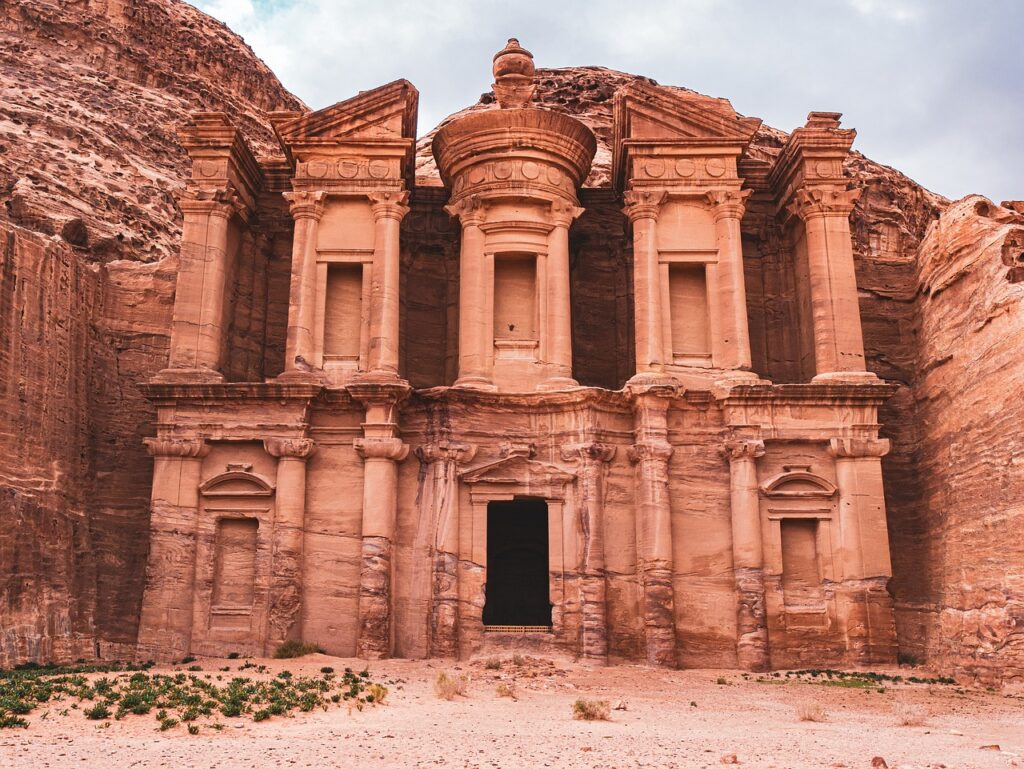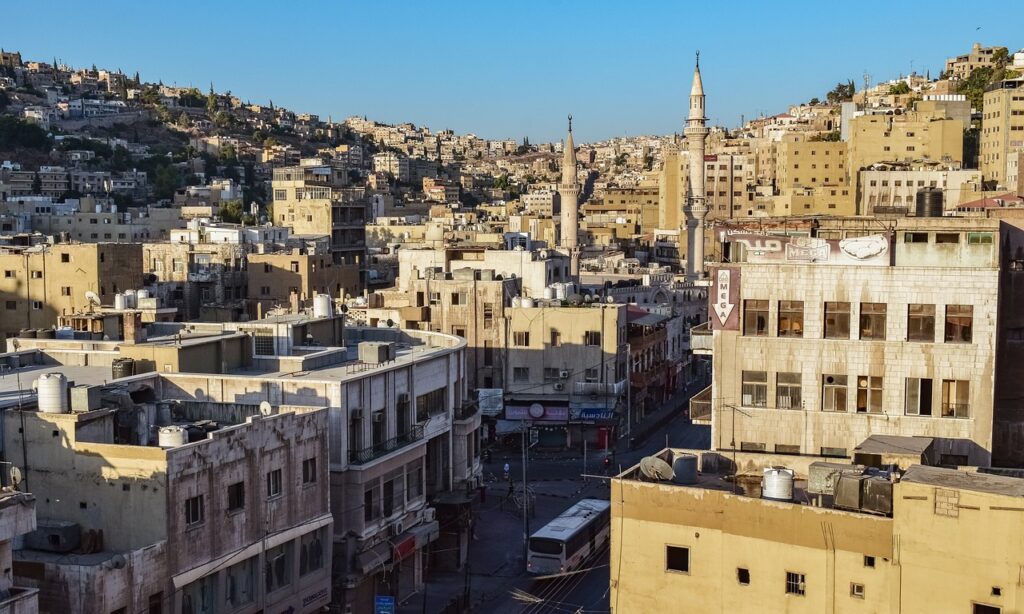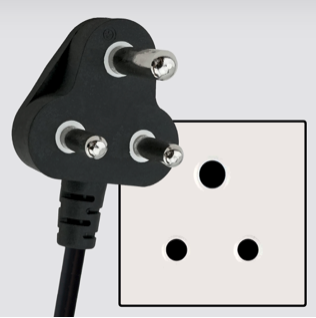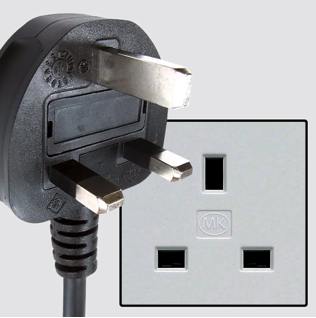Jordan / المملكة الأردنية الهاشمية – Let’s explore here
What’s it like in Jordan?
Jordan is a beautiful country in western Asia. About the size of Portugal, to the east of the country lies desert, whilst in the west, rain is plentiful and the land is very fertile. The highest point is Jabal Umm ad Dami, in the south of the country, near border with Saudi Arabia, at 6,083 ft (1,854 m) above sea level.
Home to several empires spanning a very long and rich history. Its current borders were formed in 1921, after the fall of the Ottoman Empire. The magnificent ancient city of Petra is located in the south west of the country, close to the border with Israel.
The population of Jordan is around 11½ million people (2023), about four million of whom live in the capital, Amman. Its neighbours include Saudi Arabia, Iraq, Syria, Egypt, Israel and the Palestine territories.


A bit about the history of Jordan
Ancient History and Early Civilisations
The area that is now Jordan has a rich history, with evidence of human habitation dating back to the Paleolithic period. The region was home to several ancient civilisations, including the Ammonites, Moabites, and Edomites. These peoples left behind significant archaeological remains, and their kingdoms were often mentioned in the Hebrew Bible. The ancient city of Petra, located in southern Jordan, became a major center of trade during the Nabatean Kingdom around the 4th century BC. Petra flourished under the Nabateans and became famous for its rock-cut architecture and water management systems.
Roman and Byzantine Rule
In the 1st century BC, the region came under Roman control. The area of Jordan was part of the Roman province of Arabia Petraea, and many Roman ruins, such as the city of Jerash (Gerasa), are still visible today. The region later became part of the Byzantine Empire, which ruled it for several centuries. Christianity spread throughout the area during the Byzantine period, and Jordan became home to many important early Christian sites.
Islamic Rule
In the 7th century, the Muslim Caliphate expanded into the Levant, and the region became part of the Islamic world. During the Umayyad and Abbasid Caliphates, Jordan was a part of various administrative divisions within the larger Islamic empires. The spread of Islam had a profound influence on the culture, architecture and social structures in the region.
Ottoman Empire
In the 16th century, Jordan became part of the Ottoman Empire, where it remained for several centuries. Under Ottoman rule, the area was sparsely populated and largely rural, with the Ottomans using it as a buffer zone between their empire and the Arabian Peninsula. During this period, Jordan saw limited economic and cultural development compared to other parts of the empire.
World War I and the Arab Revolt
During World War I, the Ottoman Empire sided with the Central Powers, and the Arab Revolt, supported by the British, sought to free Arab lands from Ottoman rule. The revolt, led by Sharif Hussein bin Ali of Mecca, aimed to establish an independent Arab state. British officer T.E. Lawrence, also known as ‘Lawrence of Arabia’, played a key role in supporting the revolt. Following the defeat of the Ottomans, the British gained control over parts of the Levant, including what is now Jordan. The area was placed under British mandate as part of the post war division of the Ottoman Empire.
Establishment of the Hashemite Kingdom
In 1921, the British established the Emirate of Transjordan, a semi-autonomous territory under the rule of Emir Abdullah I, a member of the Hashemite family. This decision was made after the British recognised the importance of having a stable and friendly government in the region. In 1946, Transjordan gained full independence and became the Hashemite Kingdom of Jordan, with Abdullah I as its king.
Post-Independence and Conflicts
After independence, Jordan played a significant role in regional politics, particularly in the Arab-Israeli conflict. During the 1948 Arab-Israeli War, Jordan annexed the West Bank and East Jerusalem, areas that were later captured by Israel in the 1967 Six-Day War. Jordan faced domestic challenges, including political tensions between its East Bank Bedouin population and Palestinian refugees who had fled to Jordan after the 1948 war. In the 1970s, the Jordanian government, led by King Hussein, faced an internal threat from Palestinian militant groups. The Jordanian military fought the Palestine Liberation Organization (PLO) in what became known as ‘Black September’ in 1970, resulting in the expulsion of the PLO from Jordan.
Peace with Israel and Modern Jordan
In 1994, King Hussein of Jordan signed a peace treaty with Israel, becoming the second Arab country to officially recognize Israel after Egypt. This treaty has helped stabilize Jordan’s relations with Israel and the West. Jordan has maintained a relatively stable political system under the Hashemite monarchy, despite regional instability in the Middle East. In recent years, Jordan has faced challenges related to the Syrian civil war, the influx of refugees, and economic difficulties. Despite these challenges, the country remains an important political and diplomatic player in the Middle East.
Current Political and Social Landscape
Jordan is a constitutional monarchy with King Abdullah II as the current monarch. The political system is a blend of monarchy and parliamentary democracy, with a focus on maintaining stability and security in a volatile region. The Jordanian economy relies heavily on foreign aid, tourism and remittances from Jordanians working abroad. Jordan is also a key partner in the fight against terrorism and plays a role in promoting peace in the Middle East. The country has developed a reputation as a moderate and peaceful actor, advocating for a two-state solution to the Israeli-Palestinian conflict and hosting numerous refugee populations. The country continues to face economic challenges, including high unemployment and public debt, but remains an important regional actor in the Arab world.

Jordan road trip
Our road trip through Jordan started in Aqaba, travelling up to the magnificent ancient city of Petra and on to the Dead Sea. From there we headed to the capital, Amman, which we used a base to journey to the far reaches of the country, before heading back to Aqaba.
This route really improved our knowledge of this intriguing and beautiful country, and enabled us to meet some interesting people.
Map of our road trip through Jordan

What’s it like to drive in Jordan?
They drive on the right hand side of the road in Jordan. In the main, roads are quite good, although there are many unsurfaced dirt tracks. Driving standards are also quite good.
Do you require an international driving permit in Jordan?
We’ve created a dedicated page to driving abroad, which answers this question, and more, which you might find helpful.
Can you use your UK driving license when driving through Jordan?
We’ve created a dedicated page to driving abroad, which answers this question, and more, which you might find helpful.
Do I need a carnet de passages to drive in Jordan?
A Carnet de Passages is required to overland in Jordan. We’ve created a dedicated page to driving abroad, which answers this question, and more, which you might find helpful.
What currency do they use in Jordan?
In Jordan they use the Jordanian Dinar. Cash is widely used. The use of credit / debit cards is not widely accepted. Travellers cheques are not readily accepted. There are many ATMs in cities and towns throughout the country.
You should make yourself aware of the amount that your bank charges you for using credit and debit cards abroad. Often credit cards are cheaper for purchasing items directly, and for withdrawing cash from ATMs.
What language do they speak in Jordan?
They speak Arabic in Jordan. We found that English is also very widely spoken.
What time zone is Jordan in?
Remember, when you’re planning your next trip to take a look at what time zone it’s in.
Do I need a visa to visit Jordan?
We’ve created a dedicated, more comprehensive page on visas, which you should find helpful. Check it out!
Is wild camping legal in Jordan?
Yes, wild camping is fine in Jordan.
What plug / socket type do they use in Jordan?
In Jordan they use plug / socket types C, D, F, G and J.





Health issues in Jordan
Is it safe to drink water in Jordan?
No, it is not safe to drink tap water in Jordan. Bottled water is readily available throughout the country.
What vaccinations are required for Jordan?
This NHS website is kept up to date with all relevant information on vaccinations in Jordan.
Phones in Jordan
What is the country calling code for Jordan?
The country calling code for Jordan is +962
What are the emergency phone numbers in Jordan?
- The emergency number for police in Jordan is: 911
- In Jordan, the emergency number for ambulance is: 911
- The emergency number for fire in Jordan is: 911
If you’ve got some useful info that you’d like to share, let us know!
And don’t forget to check out all the other pictures!
